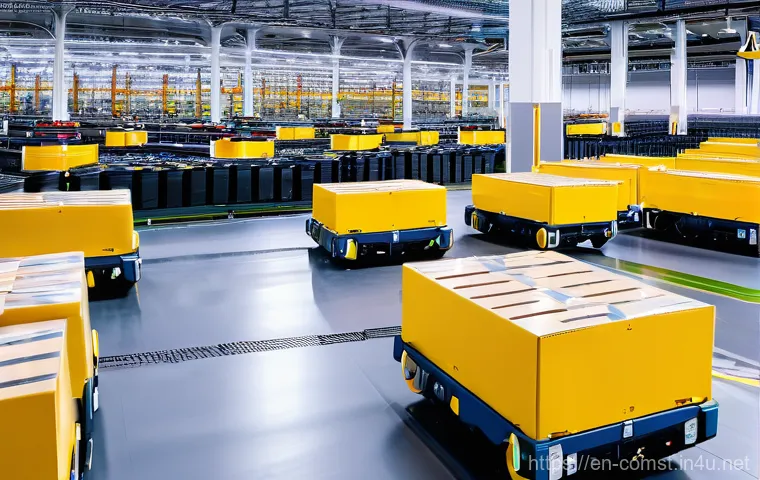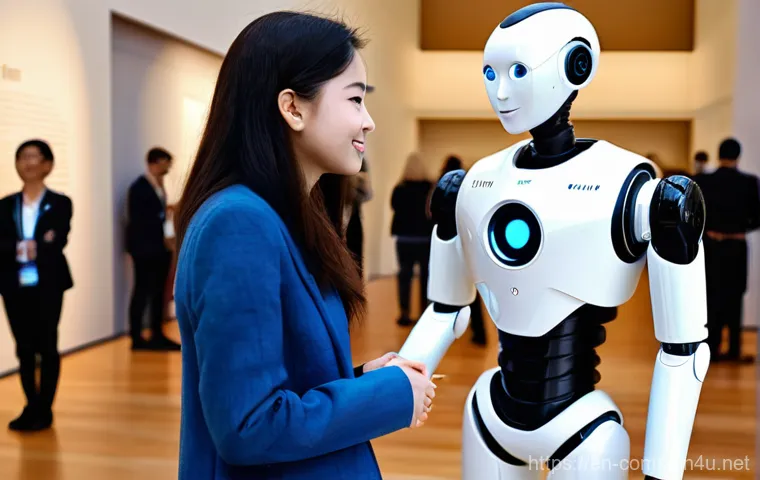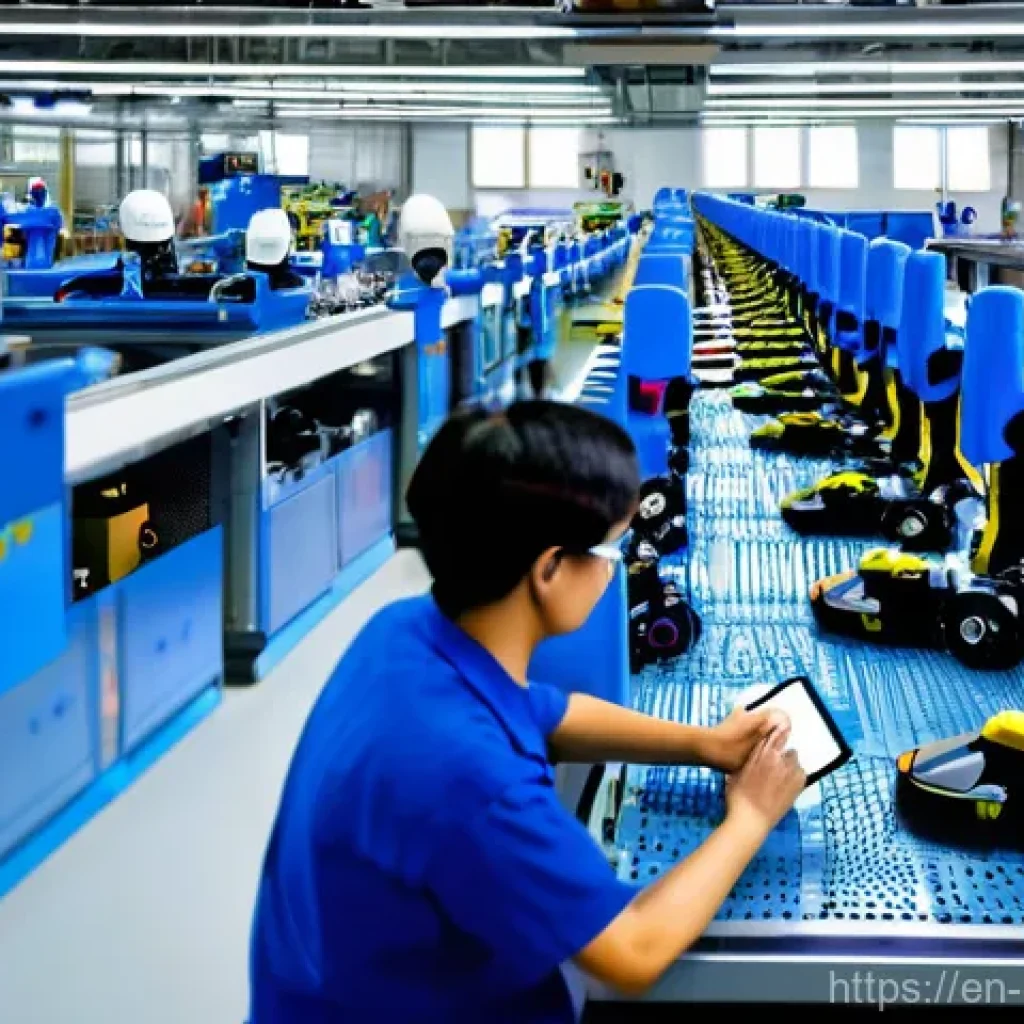Have you ever found yourself marveling at how seamlessly technology weaves into our lives? For years, robots felt like something out of a sci-fi blockbuster, an exciting but distant dream.
But honestly, they’ve quietly, yet profoundly, reshaped our world right under our noses. From the smart little vacuum whizzing around your living room to the massive, precision-guided arms in a factory, intelligent robotics is no longer just a futuristic concept – it’s a living, breathing revolution unfolding before our eyes.
I’ve been keeping a close watch on this space, and what truly fascinates me is how AI is giving these machines the ability to learn and adapt in ways we only dreamed of a decade ago.
Think about it: collaborative robots, often called ‘cobots,’ are now working safely alongside humans, boosting efficiency in manufacturing and logistics without us even noticing.
Then there are the autonomous mobile robots revolutionizing how goods move, making sure your online orders arrive faster than ever. We’re even seeing mind-blowing advancements in humanoid robots, moving beyond industrial settings to tasks that require a human-like touch, and the buzz around generative AI is simplifying how we interact with them, almost like speaking to a super-smart assistant.
This isn’t just about efficiency; it’s about unlocking entirely new possibilities, pushing the boundaries of what’s achievable in healthcare, deep-sea exploration, and even our daily routines.
Of course, with such incredible progress, thoughtful conversations about societal impact, job evolution, and ethical guidelines are more important than ever.
Curious to dive deeper into how intelligent robots are not just assisting us, but truly transforming every corner of our existence? Let’s unravel the complete picture together.
Our New Coworkers: The Dawn of Collaborative Robotics

It wasn’t long ago that the idea of a robot working right next to you on a factory floor seemed like a scene straight out of a movie, filled with safety concerns and a lot of clunky, rigid movements. But let me tell you, that perception is completely outdated! What I’ve seen firsthand, observing these incredible machines in action, is a revolution spearheaded by what we call ‘cobots’ – collaborative robots. They’re designed from the ground up to share workspaces with humans, creating an incredibly dynamic and efficient environment. The shift in manufacturing alone is monumental. We’re talking about machines that can handle repetitive, strenuous, or even dangerous tasks, freeing up human workers for more complex problem-solving, creative input, and quality control. It’s not about replacing people; it’s about empowering them to do their best work, making their jobs safer and more engaging. I’ve always been a bit of a tech enthusiast, but seeing the seamless integration of these cobots into daily operations truly blew me away – it’s a testament to how far we’ve come.
Working Side-by-Side: Safety and Efficiency Redefined
One of the biggest hurdles for industrial robots used to be safety. They were big, fast, and needed to be caged off for human protection. Cobots, on the other hand, are engineered with advanced sensors and intelligent programming that allow them to detect and react to human presence, often slowing down or stopping entirely if someone gets too close. This isn’t just a fancy feature; it’s a game-changer. I remember visiting a small manufacturing plant, and the production manager was raving about how their new cobot arm was carefully assembling delicate components alongside their technicians. The precision was breathtaking, but what really struck me was the team’s comfort level. They weren’t just tolerating the robot; they were actively collaborating with it, passing parts back and forth. This dramatically boosts efficiency because there’s no downtime for safety protocols that isolate humans from machines. It truly feels like a partnership, where the robot handles the grunt work, and the human provides the nuanced skill and oversight. It redefines what ‘teamwork’ means in an industrial context, and honestly, it’s thrilling to witness.
Beyond the Assembly Line: Cobots in Diverse Roles
While manufacturing is where cobots got their start, their adaptability means they’re popping up in the most unexpected places. I recently read about a cobot in a pharmaceutical lab, meticulously pipetting liquids with a level of accuracy and consistency that no human could maintain for hours on end. Then there are the logistics companies, where cobots are assisting with packaging, sorting, and even quality checks, making sure your online orders are perfect before they leave the warehouse. And let’s not forget the culinary world! I’ve even seen videos of cobots assisting chefs with repetitive tasks like chopping vegetables or decorating cakes, allowing the human chef to focus on the creative aspects of cooking. It’s truly amazing how these versatile machines are being customized for niche applications, proving that their collaborative nature isn’t just confined to heavy industry. The sheer breadth of their potential is something I find incredibly exciting, and it constantly reminds me that innovation truly knows no bounds.
Wheeled Wonders: Autonomous Mobile Robots on the Move
If you’ve ever ordered something online and had it arrive at your door seemingly within hours, you might have an autonomous mobile robot (AMR) to thank. These aren’t your typical factory robots chained to one spot; AMRs are the free-roaming agents of the intelligent robotics world, bustling around warehouses, hospitals, and even public spaces. When I first learned about them, I imagined something akin to glorified remote-controlled cars, but that’s a massive understatement. These machines are incredibly sophisticated, equipped with advanced navigation systems, LiDAR, cameras, and AI that allow them to understand their environment, avoid obstacles, and plot the most efficient routes – all without human intervention. It’s like they have their own little brains guiding them through complex, dynamic environments. The impact on logistics, particularly, has been nothing short of transformative. The speed and accuracy with which they can retrieve, transport, and sort items are pushing the boundaries of what’s possible in supply chain management. It truly feels like we’re watching the future of logistics unfold right before our eyes, making our lives more convenient with every package delivered.
Mastering the Logistics Maze: From Warehouses to Deliveries
Think about a massive e-commerce warehouse, sprawling over hundreds of thousands of square feet, packed with millions of items. Manually navigating that space, picking orders, and transporting them is a colossal, time-consuming, and error-prone task. This is exactly where AMRs shine. I’ve seen footage from cutting-edge fulfillment centers where fleets of these robots work in perfect harmony, zipping between aisles, picking up shelves laden with products, and bringing them directly to human packers. This ‘goods-to-person’ approach drastically cuts down on the walking time for human workers, boosting productivity exponentially. But it’s not just internal logistics. Some AMRs are now venturing outdoors, piloting last-mile deliveries in designated zones, carrying groceries or packages right to your doorstep. While this is still an emerging area, the potential to revolutionize urban delivery networks, reduce traffic congestion, and lower carbon footprints is immense. It’s a logistical ballet, perfectly choreographed by AI, and it’s making our consumer-driven world operate with unprecedented speed.
The Brains of the Operation: How AMRs Navigate Complex Environments
What really sets AMRs apart from earlier automated guided vehicles (AGVs) is their intelligence. AGVs follow fixed paths – lines on the floor or embedded wires. AMRs, however, are dynamic navigators. They build internal maps of their surroundings, much like a human exploring a new building. Using simultaneous localization and mapping (SLAM) technology, they can understand where they are, where they’re going, and how to get there, even if the environment changes. If an unexpected obstacle appears – say, a fallen box or a human worker – the AMR doesn’t just stop; it recalculates its route in real-time and finds a way around it. This adaptability is crucial in busy, unpredictable environments like hospital corridors or active warehouses. It’s this advanced cognitive ability, powered by sophisticated algorithms and sensor fusion, that truly allows AMRs to operate autonomously and safely, making them an indispensable part of modern infrastructure. It’s fascinating to think about the complex calculations happening within these machines as they glide effortlessly through our world.
Stepping into the Future: The Evolution of Humanoid Robots
For a long time, humanoid robots felt like the ultimate sci-fi fantasy, something only seen in movies. But trust me when I say, the advancements in this field are absolutely mind-boggling, moving beyond clunky prototypes to genuinely impressive machines. We’re talking about robots that aren’t just designed to look like us but are also beginning to interact with the world in ways that mirror human movement and capability. When I first encountered the latest generation of humanoids, I was genuinely taken aback by their fluidity. They can walk, run, balance on uneven terrain, and even manipulate objects with a dexterity that was unimaginable just a few years ago. This isn’t just about aesthetics; it’s about creating robots that can operate in environments designed for humans, performing tasks that require a human-like form factor. The implications are vast, from disaster recovery in dangerous environments to assisting the elderly in their homes. It’s a field that constantly pushes the boundaries of engineering and AI, and every new development makes me feel like we’re genuinely living in the future.
More Than Just Machines: Embodying Human-like Interaction
What truly fascinates me about humanoids is their potential for interaction. It’s one thing for a robot arm to assemble a car, but it’s another entirely for a robot to, say, greet you at a reception desk, guide you through a museum, or even provide companionship. The challenge lies not just in mimicking human movement but in understanding and responding to human social cues. We’re seeing rapid progress in this area, with robots incorporating advanced facial recognition, voice analysis, and even rudimentary forms of ‘theory of mind’ to better interpret human intentions. While we’re still a ways off from truly sentient robots, the ability for these machines to engage in more natural, intuitive interactions is incredibly powerful. Imagine a healthcare setting where a humanoid robot can provide basic information, fetch supplies, or even offer a comforting presence to patients, allowing human staff to focus on critical care. It’s about designing technology that feels less like a tool and more like an extension of our own capabilities, creating truly empathetic and helpful companions.
Breaking New Ground: Humanoids in Service and Exploration
The applications for advanced humanoid robots are expanding exponentially. Beyond factories, we’re seeing humanoids being developed for hazardous environments, such as inspecting nuclear power plants or aiding in search-and-rescue operations where human lives would be at too great a risk. Their ability to navigate stairs, open doors, and manipulate tools designed for human hands makes them invaluable in these scenarios. On the lighter side, humanoid robots are also being explored for customer service roles, providing information and assistance in retail or hospitality, offering a novel and engaging experience for customers. There’s even talk of them assisting in deep-sea exploration or space missions, performing tasks too dangerous or complex for human astronauts to manage easily. The versatility of a human-like form, combined with cutting-edge AI, means that these robots are poised to tackle some of humanity’s biggest challenges, pushing the boundaries of what’s physically and technologically possible in our world.
Unlocking Potential: The AI That Powers Intelligent Machines
At the heart of every intelligent robot, whether it’s a tiny AMR or a sophisticated humanoid, lies a powerful engine: Artificial Intelligence. I often think of it as the ‘brain’ that gives these machines their ability to perceive, process, and act. Without AI, robots would just be complex automatons, repeating pre-programmed sequences. But with AI, they become adaptable, capable of learning from their experiences and making decisions in dynamic environments. It’s this symbiotic relationship between advanced hardware and sophisticated software that has truly propelled robotics into its current revolutionary phase. My journey into understanding robotics really deepened when I started to grasp just how profoundly machine learning and generative AI are shaping what these machines can do. It’s not just about crunching numbers; it’s about enabling them to understand the nuances of our world and respond in ways that feel increasingly natural and intuitive. This synergy is what makes the field so vibrant and endlessly fascinating for me.
Learning and Adapting: Machine Learning’s Role in Robotics
Machine learning is the secret sauce that allows robots to move beyond simple automation. Instead of being explicitly programmed for every single scenario, robots powered by machine learning can learn from data, identify patterns, and make predictions or decisions. Take, for instance, a robot gripper learning to pick up oddly shaped objects it’s never encountered before. Through deep learning, it can analyze countless images and simulations, gradually refining its grasp until it achieves success. Or consider a self-driving car (which, at its core, is a highly sophisticated AMR) navigating complex city streets. It learns from millions of miles of driving data, identifying pedestrians, traffic lights, and potential hazards with incredible accuracy. This iterative learning process is what makes intelligent robots truly ‘smart’ – they aren’t just following instructions; they are evolving their capabilities with every interaction. It truly mirrors how humans learn from experience, albeit at a scale and speed we can only dream of.
Conversational Companions: Generative AI and Human-Robot Interaction
If machine learning gives robots the ability to learn, then generative AI is giving them the power to communicate and create in astonishing ways. The buzz around large language models and advanced speech synthesis isn’t just for chatbots; it’s profoundly impacting how we interact with robots. Imagine being able to tell a robot, in natural language, “Hey, can you help me find that wrench I used yesterday and bring it over?” instead of having to program specific commands. Generative AI allows robots to understand complex, nuanced requests, process them, and even formulate coherent responses. It’s making human-robot interaction feel much more intuitive and less like interacting with a rigid machine. This is a massive leap forward, especially for service robots or humanoids designed to assist in daily life. It means less training for us, and more intelligent, adaptive service from them. From my perspective, this makes robots far more accessible and truly integrates them into our daily routines in ways we’re only just beginning to explore.
Transforming Industries: Where Robots Make a Real Difference

When we talk about intelligent robotics, it’s not just a theoretical concept; it’s a powerful force actively reshaping various sectors, bringing tangible benefits and pushing the boundaries of efficiency and safety. I’ve always been keen on seeing how cutting-edge tech translates into real-world impact, and robotics truly delivers on this front. From the sterile environments of hospitals to the bustling floors of manufacturing plants, these machines are not just assisting; they’re revolutionizing how work gets done. It’s fascinating to observe how different industries are adopting these innovations, each finding unique ways to leverage the capabilities of intelligent robots to solve long-standing challenges. The sheer diversity of applications showcases the incredible versatility of this technology, proving that robots are far more than just industrial arms; they are becoming indispensable partners across the economic spectrum. The breadth of their influence makes this topic endlessly engaging for anyone interested in the future of work and innovation.
Precision and Productivity: Manufacturing’s Robotic Revolution
Manufacturing has been the earliest and perhaps most dramatic beneficiary of robotics, and intelligent robots are taking this to an entirely new level. Beyond the repetitive tasks, robots are now performing intricate assembly, precise welding, and quality inspections with a consistency and speed that human workers simply cannot match over extended periods. This isn’t just about cranking out more products; it’s about achieving unparalleled levels of precision and reducing waste, leading to higher quality goods and more sustainable production processes. I recall seeing an automotive plant where robots were applying paint layers with micron-level accuracy, ensuring a flawless finish every time. This kind of precision not only enhances product quality but also reduces material usage, which is a win for both the company’s bottom line and the environment. It truly feels like these robots are not just tools but essential components of a highly optimized and efficient manufacturing ecosystem.
Caring Hands: Robots in Healthcare and Beyond
The healthcare sector is another area where intelligent robots are making a profound impact, often in ways that are deeply compassionate and life-saving. Surgical robots, for example, allow doctors to perform complex procedures with enhanced precision, minimally invasive techniques, and faster patient recovery times. Then there are pharmacy automation robots that accurately dispense medications, reducing human error and ensuring patient safety. In hospitals, AMRs transport supplies, laboratory samples, and even meals, freeing up nurses and other staff to focus on direct patient care. I’ve even seen prototypes of robotic exoskeletons designed to assist rehabilitation for patients with mobility issues, helping them regain strength and independence. It’s truly inspiring to see how this technology is being harnessed not just for industrial gain, but for improving human well-being and extending our capabilities in critical fields. The human impact of these innovations is something I find incredibly moving.
A Glimpse into Tomorrow: The Road Ahead for Robotics
Looking ahead, the trajectory of intelligent robotics is nothing short of breathtaking. What we’ve seen so far feels like just the tip of the iceberg, and the pace of innovation continues to accelerate. As someone who’s always got an eye on the horizon, I can tell you that the discussions around robotics are becoming more nuanced, encompassing not just technological capabilities but also the broader societal implications. It’s a dynamic field where new breakthroughs happen almost daily, from more agile locomotion to increasingly sophisticated AI. The integration of advanced sensors, more powerful processors, and increasingly refined algorithms means that robots will continue to evolve, becoming even more autonomous, adaptable, and integrated into our daily lives. It’s a journey into uncharted territory, and honestly, the possibilities feel limitless, making it one of the most exciting areas to observe in the entire tech landscape right now.
Ethical Crossroads: Navigating the Impact on Society and Jobs
With great power comes great responsibility, and intelligent robotics is no exception. As robots become more capable, thoughtful conversations about their societal impact are more crucial than ever. One of the most frequently discussed topics is the future of work. Will robots displace jobs, or will they create new ones? My personal take is that it’s likely a bit of both. Many repetitive, dangerous, or physically demanding jobs will undoubtedly be automated, but this also opens up opportunities for humans to engage in more creative, strategic, and oversight roles. Then there are the ethical considerations: how do we ensure robots are programmed to make safe and equitable decisions? What are the boundaries of human-robot interaction? These aren’t easy questions, and they require collaboration between technologists, policymakers, ethicists, and the public. It’s a complex dance between innovation and responsibility, and navigating these ethical crossroads thoughtfully is paramount to ensuring a beneficial future for everyone.
The Next Frontier: Pushing the Boundaries of What’s Possible
So, what’s next for intelligent robotics? If I had to guess, I’d say we’re going to see an explosion in truly personalized robotic assistants, moving beyond simple voice assistants to physical companions capable of performing a wide array of household tasks, providing elder care, or even offering educational support for children. Imagine a robot that can not only clean your house but also learn your preferences, anticipate your needs, and even remind you to water your plants! We’re also likely to see more widespread adoption of micro-robots for tasks like targeted drug delivery within the human body or environmental monitoring in hard-to-reach places. The fusion of robotics with advanced materials science could lead to robots that are softer, more flexible, and even more responsive to their surroundings. The innovation never stops, and every new development serves as a reminder that the future of robotics is not just about building smarter machines, but about expanding the horizons of human potential itself.
| Robot Type | Key Characteristics | Typical Applications |
|---|---|---|
| Collaborative Robots (Cobots) | Designed for safe human-robot interaction; flexible and easy to program. | Assembly, packaging, material handling, quality inspection in manufacturing. |
| Autonomous Mobile Robots (AMRs) | Self-navigating; perceive and adapt to dynamic environments; no fixed paths. | Warehouse logistics, last-mile delivery, hospital material transport. |
| Humanoid Robots | Mimic human form and movement; designed for human-centric environments. | Customer service, education, hazardous environment exploration, assistance for elderly. |
| Surgical Robots | High precision for delicate operations; often minimally invasive. | Complex surgeries, medical training, rehabilitation assistance. |
글을 마치며
Whew! What a journey we’ve taken through the incredible world of intelligent robotics. Honestly, diving into these topics always leaves me buzzing with excitement about the future. It’s truly amazing to witness how quickly these technologies are evolving, moving from niche applications to becoming integral parts of our daily lives and industries. From the collaborative spirit of cobots on the factory floor to the silent efficiency of AMRs in logistics, and the breathtaking advancements in humanoids, we’re genuinely on the cusp of a new era. What I personally find most compelling is the underlying AI, constantly learning and adapting, making these machines not just tools, but intelligent partners. It’s a testament to human ingenuity, pushing boundaries and redefining what’s possible, and I can’t wait to see what innovations are just around the corner!
알아두면 쓸모 있는 정보
1. Exploring a Career in Robotics: If you’re as fascinated by this field as I am, consider looking into educational paths in robotics engineering, AI, or mechatronics. Universities worldwide are expanding their programs, and online courses are plentiful. It’s a high-demand sector with incredible growth potential, offering roles from hardware design to AI development and system integration. Don’t be afraid to start with beginner-friendly coding projects or join local robotics clubs – hands-on experience is truly invaluable!
2. The Impact on Small Businesses: While we often think of large corporations adopting robots, cobots and smaller AMRs are becoming increasingly accessible and affordable for small and medium-sized enterprises (SMEs). They can significantly boost productivity, reduce labor costs for repetitive tasks, and even help smaller companies compete more effectively in a global marketplace. It’s worth exploring grants or leasing options if you run a business that could benefit from automation.
3. Understanding AI Ethics: As robots become more intelligent, the ethical considerations around AI and automation are growing. Take some time to learn about topics like algorithmic bias, data privacy, and the future of work. Being informed allows us to contribute to crucial conversations about how we want technology to shape our society. There are many great online forums and books dedicated to AI ethics that offer diverse perspectives.
4. Investing in the Robotics Sector: For those interested in the financial side, the robotics and automation market is booming. Look into publicly traded companies specializing in robotics, AI hardware, or industrial automation. Exchange-Traded Funds (ETFs) focused on robotics can also be a good way to gain diversified exposure to this exciting growth industry, but always remember to do your own thorough research before making any investment decisions.
5. Staying Ahead of the Curve: The robotics landscape changes incredibly fast. To keep up, I highly recommend following leading tech journals, subscribing to robotics news outlets, and attending virtual or in-person industry conferences. Engaging with communities of robotics enthusiasts and professionals on platforms like LinkedIn or Reddit can also provide fresh insights and perspectives on the latest breakthroughs and trends.
중요 사항 정리
The Rise of Collaborative Robotics and AMRs
Our exploration highlighted that robots are no longer confined to cages. Collaborative robots (cobots) are redefining industrial safety and efficiency by working alongside humans, handling strenuous tasks while people focus on complex problem-solving. Similarly, Autonomous Mobile Robots (AMRs) are revolutionizing logistics, navigating dynamic environments in warehouses and even beginning to manage last-mile deliveries, significantly boosting speed and accuracy in supply chains. These machines are adaptable, intelligent, and designed to enhance human capabilities, not replace them entirely.
Humanoids and AI: The Brains and Brawn of the Future
The advancements in humanoid robots are pushing the boundaries of what’s physically possible, allowing machines to operate in human-centric environments for tasks like disaster recovery or elder care. At the core of all intelligent robotics lies Artificial Intelligence. Machine learning enables robots to learn and adapt from data, moving beyond simple automation to dynamic decision-making. Generative AI, meanwhile, is facilitating more natural human-robot interaction, allowing for intuitive communication and making robots more accessible and integrated into our daily routines, from service roles to personal assistance.
Transforming Industries and Navigating the Future
Intelligent robots are actively reshaping diverse sectors. Manufacturing continues to benefit from unparalleled precision and productivity, while healthcare sees life-saving applications in surgical robots, pharmacy automation, and patient assistance. Looking ahead, the ethical implications surrounding job displacement and equitable AI decision-making are critical conversations that demand collaboration across society. The future promises personalized robotic assistants and micro-robots, continually expanding human potential and tackling humanity’s biggest challenges through constant innovation.
Frequently Asked Questions (FAQ) 📖
Q: Okay, so intelligent robots are here, but how are they really impacting our everyday lives and not just big factories?
A: That’s a fantastic question, and it’s honestly where the magic really starts to happen! For years, when we thought of robots, our minds went straight to massive assembly lines, right?
But what I’ve seen, and what truly excites me, is how intelligent robots are quietly yet powerfully weaving themselves into the fabric of our daily routines in ways we might not even notice.
Think about it: beyond those smart vacuum cleaners whirring around your living room, we’re seeing incredible advancements in healthcare. Imagine surgical robots assisting doctors with unbelievable precision, leading to faster recovery times for patients.
Or how about in logistics, where autonomous mobile robots (AMRs) are zipping around warehouses, making sure your online orders arrive on your doorstep faster than ever before.
It’s not just about speed; it’s about making systems more efficient and ultimately, freeing up human potential for more complex, creative tasks. I genuinely believe that these subtle integrations, from making our homes smarter to revolutionizing how hospitals operate, are the true game-changers.
It’s no longer just about heavy lifting; it’s about intelligent assistance everywhere.
Q: You mentioned ‘cobots,’ ‘autonomous mobile robots,’ and even ‘humanoid robots.’ What’s the practical difference between these, and where are they making the biggest splash?
A: Great follow-up! It’s easy for all these terms to get a bit muddled, but understanding their differences is key to seeing the bigger picture of intelligent robotics.
From my experience watching this space evolve, these categories serve distinct, yet often complementary, purposes. First up, Collaborative Robots, or Cobots.
These are designed to work with humans, not just alongside them. Think of them as incredibly precise and tireless assistants. What makes them unique is their built-in safety features, allowing them to operate in shared workspaces without needing extensive caging.
I’ve seen them used extensively in manufacturing for tasks like assembly, packaging, and quality inspection, taking over repetitive or ergonomically challenging jobs.
They free up human workers to focus on more intricate or supervisory roles. Then we have Autonomous Mobile Robots (AMRs). As the name suggests, these robots move independently.
Unlike older Automated Guided Vehicles (AGVs) that needed magnetic strips or wires to follow, AMRs use sophisticated sensors and AI to navigate dynamic environments, avoiding obstacles and finding the most efficient routes.
They’re making a massive splash in logistics, warehousing, and even healthcare, transporting materials, goods, and supplies without human intervention.
The efficiency boost they bring to supply chains is truly remarkable. Finally, Humanoid Robots. These are perhaps the most captivating because, well, they look like us!
While they’re still very much a developing field, I’ve seen some mind-blowing progress. They’re designed to interact with the world in a human-centric way, opening doors for tasks that require a human-like form factor or a more natural interaction with people and tools.
Imagine them in elder care, performing household tasks, or even in hazardous environments where human presence is too risky. While their full potential is still unfolding, the buzz around them, especially with advancements in generative AI for more natural communication, hints at a future where they could truly bridge the gap between human and machine interaction in our daily lives.
Each type has its unique strengths, and together, they’re pushing the boundaries of what’s possible!
Q: This sounds incredible, but it also brings up some concerns. What are the biggest ethical and societal challenges we face as intelligent robotics becomes more widespread?
A: You’re absolutely hitting on one of the most critical aspects of this revolution. While the technological advancements are breathtaking, it would be shortsighted of us not to engage in thoughtful conversations about the societal and ethical implications.
From my perspective, having followed these developments closely, there are a few key areas that really stand out. One of the most immediate concerns for many people, myself included at first, is the impact on jobs.
As robots become more capable, especially with AI, there’s a natural worry about job displacement. While many experts, and my own observations, suggest robots often augment human labor rather than replace it entirely, we do need to proactively think about reskilling and upskilling programs.
We need to prepare the workforce for new roles that will emerge – roles that often involve managing, maintaining, and collaborating with these intelligent machines.
Then there’s the big one: ethical guidelines. When robots operate autonomously, who is accountable if something goes wrong? How do we program them to make ethical decisions, especially in complex, real-world scenarios?
This is particularly relevant for autonomous vehicles or robots in critical care. Ensuring transparency in their decision-making processes and establishing clear lines of responsibility are paramount.
It’s not just about programming them to be efficient, but also to be responsible. Finally, there are broader societal impacts, like privacy concerns when robots collect data, or the potential for a widening gap between those who benefit from these technologies and those who don’t.
We need to ensure equitable access and prevent a future where advanced robotics exacerbates existing inequalities. These aren’t easy questions, and there are no quick answers, but acknowledging them and fostering open dialogue across governments, industries, and civil society is the only way we can steer this incredible technological wave towards a future that truly benefits everyone.






